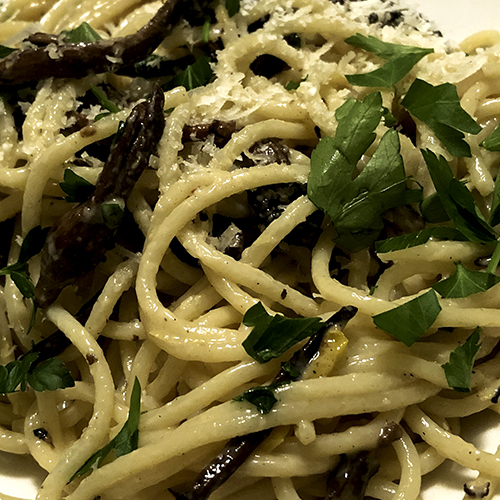
It’s not that I don’t appreciate the incredibly huge variety of local seafood available through the seasons from the fishers in New York’s Union Square Greenmarket four days of the week. It’s just that I’m an obsessive for anything new.
Yesterday, long after I made it home with a ‘catch’ that I had never come across anywhere, at least on the eastern seaboard, I began to doubt whether I would be able to bring it to the table in an edible form.

Needlefish.
It was labelled, ‘billed eel” at the Seatuck Fish stand, but I was more than skeptical of the appellation. I know a little about eel, and I’ve prepared it both fresh and smoked, but these teethy silver pencils did not look at all like they belonged to the order Anguilliformes, and there was noting snaky about them.
I had already bought swordfish steaks for our dinner, so I deliberated with myself for a while about whether to go for these absolutely beautiful creatures in addition, I didn’t know what they were, they were so very small, and there were only four left (today I’m wondering who had bought the others, and what they had one with them). Eventually, deciding to take a chance, and thinking they might make an interesting small appetizer, I scooped them up.
Once home I began to do some research, first to determine what they were. A quick search for “long narrow small ocean fish” gave me the answer: I had four small Atlantic needlefish on my hands. The second thing? Eating them wouldn’t kill you. Then I learned that they belong to an entire group of fish described as perfectly edible, even delicious, but, because of the bones, almost impossible to eat.
I spent an inordinate amount of time checking what that would mean if applied to my tiny quartet. Try searching, “how small a needlefish must you have before you can eat the bones?” Not surprising, I never found anything definitive.
So I cooked them.
In the end we were easily able to remove the backbones after the fish had been fried, and the ribs turned out to be so small that we never noticed them. Yay for optimal size! Thank you Catherine, Everett, and all the Seatuck folks!
They were delicious.
We’d both recommend needlefish to any cook or diner with the considerations mentioned above, and the cleaning process was really sort of fun.
Many thanks to the people responsible for this reassuring video, in particular for the portion showing the fish being cleaned, recorded in extraordinarily clear overhead images. Those needlefish are a little larger than the ones I had, and of course there were a lot more.
ADDENDUM:
I want to repeat that the flesh was really, really tasty, and the prep made it possible.
For the guidance of anyone reading this, I should make it clear that we were very lucky in the size of the fish we were presented with. They were neither too small nor too large. Smaller might have made the gutting more difficult, and would probably have complicated the removal of the back bones; larger would have meant the zillions of rib bones would have made eating the flesh impossible, or certainly not an experience you would want to remember.
I write that with the qualification that really small would mean they could be fried without gutting them like any really small fish, as smelts, or whitebait (a collective term for the immature fry of fish), and the much smaller backbones might have gone down with the flesh; really large would have made it practicable to cut them into fillets, eliminating all the bones, as described in this video.

This site provides some simple, accessible information about Needlefish, including a simple cooking suggestion that became the basis for my preparation last night.

- four small cleaned needlefish were splashed with fresh lemon juice and sprinkled with some local Long Island salt, from fisherman Phil Karlin of his family’s P.E. & D.D. Seafood Company, then dredged in lightly seasoned whole wheat flour from The Blew family of Oak Grove Plantation in Pittstown, N.J., the excess shaken off and the fish placed on a paper plate, while a shallow layer of sunflower oil inside a large, heavy antique very well seasoned Wagner Ware frying pan was heated until hot but not smoking, at which point the needlefish were placed inside, not touching, for a total of about 2 minutes, turning once, or until cooked and nicely crisped, removed and arranged on the plates, along with a salad of baby romaine lettuce from Quarton Farm and one sliced baby red onion from Hoeffner Farms, dressed with Whole Foods house Portuguese olive oil, lemon juice, freshly ground black pepper, and P.E. & D.D. Seafood salt, accompanied with slices from a She Wolf Bakery sourdough Bâtard

The main course was one we’re pretty familiar with, with elements that show up here frequently, always welcomed.
- two large, 9-ounce swordfish steaks, also from Seatuck Fish in the Union Square Greenmarket, marinated for more than half an hour in a mixture of a little chopped scallion from Willow Wisp Farm, a heaping teaspoon of pungent dried wild Sicilian oregano from Buon Italia, little more than a pinch of dried peperoncini Calabresi secchi from Buon Italia, and a couple tablespoons of olive oil, after which the steaks were drained, covered on both sides with a coating of homemade dried breadcrumbs (to help retain the moisture, and keep them from drying out), pan-grilled over medium-high heat for 3 or 4 minutes on each side, or until barely cooked all of the way through, removed, arranged on the plates, seasoned with a small amount of P.E. & D.D. salt, a good amount of lemon juice squeezed on top, drizzled with olive oil, and garnished with flowering fennel from Quarton Farm
- a nine or ten ounce mix of small tomatoes from Eckerton Hill Farm, halved, sprinkled on the cut side with sea salt and black pepper, heated gently on both sides inside a small copper skillet, arranged on the plates scattered with chopped leaves of pericón (Mexican tarragon) from Quarton Farm, garnished with micro cressida from Windfall Farms



















